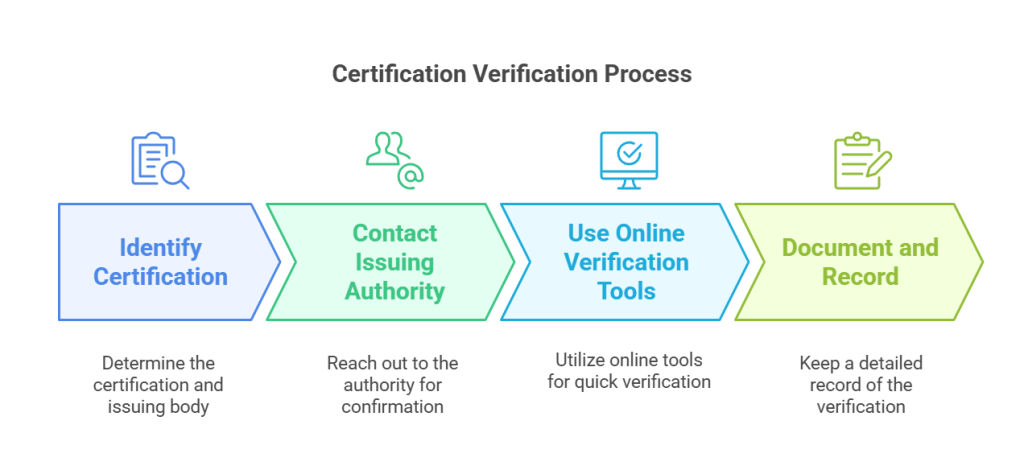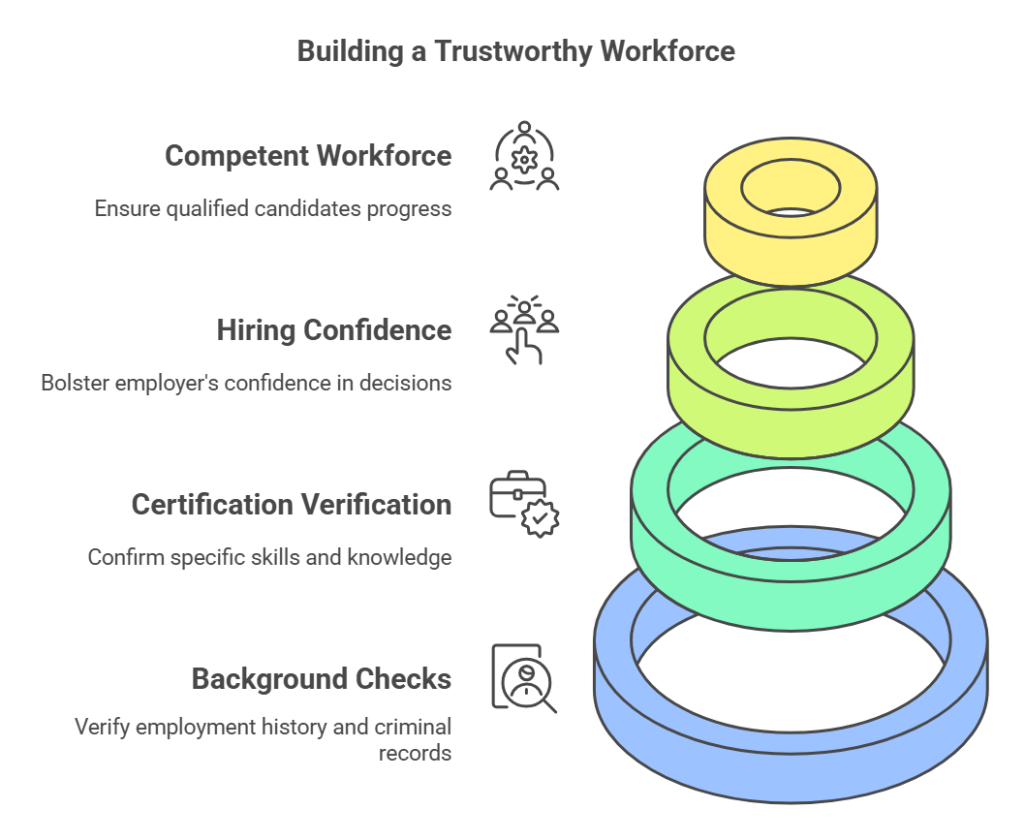Navigating the professional landscape of New York can be a thrilling yet challenging experience, especially when it comes to ensuring that all professional certifications are in order. Certification verification plays a crucial role in maintaining trust and credibility in many industries. This guide aims to help professionals, employers, and job seekers understand the intricacies of certification verification in New York and address any potential concerns related to employment background checks.
Key Takeaways
- Certification verification is essential for confirming the legitimacy and current status of a professional's credentials in sectors like healthcare, finance, and education.
- The verification process prevents hiring individuals with false credentials, reducing risks for employers and ensuring client confidence.
- Simple steps involving identifying the certification, contacting the issuing authority, and using online tools are effective for verification in New York.
- Background checks complement certification verification by offering a broader view of a candidate's qualifications and reliability.
- Compliance with legal and privacy standards during the verification process is crucial for maintaining ethical hiring practices.
Understanding Certification Verification
Certification verification isn't just a box to tick off—it's about confirming that someone's claimed credentials are real and still active. In essence, it's a process that checks whether a certificate was genuinely awarded by a legitimate institution and whether it's up-to-date. This is particularly crucial in industries like healthcare, finance, and education. These fields rely heavily on certifications to validate that individuals have the needed skills and knowledge.
In healthcare, for example, patient safety hinges on medical professionals being properly certified. Similarly, in finance, certifications demonstrate a person's ability to handle sensitive financial data responsibly. In education, verified certifications ensure that educators meet the necessary standards to teach effectively. Across these sectors, certification verification acts as a safeguard, maintaining the standards of practice that society expects.
The process isn't cumbersome, and its relevance can't be overstated. Without it, the risk of employing individuals with inflated or false credentials rises considerably. This can lead to serious implications, not just for employers, but also for clients or patients who rely on a professional's expertise. In short, certification verification is about instilling confidence—making sure that when someone claims they’re qualified, they truly are.
What Is Certification Verification?
Certification verification checks whether a professional's credentials are genuine and up-to-date. This involves confirming that a certificate was issued by an accredited organization and that it's still valid. It's a must-have step in fields like healthcare, finance, and education, where certifications prove a person's expertise and skills. Ensuring the authenticity of these credentials is crucial for trustworthiness and professionalism in any workplace.
Why Is Certification Verification Important?
Making sure certifications are valid isn't just a formality—it's a pillar of professional integrity. Trust and credibility hinge on knowing that the person you're hiring or working with actually knows what they're doing. In fields like healthcare or finance, it isn't just about keeping up appearances. It's about ensuring that the people handling critical tasks are genuinely qualified to do so.
There's also the legal angle. Some occupations are bound by law to only allow certified individuals to operate. This means companies have to keep a close watch on certification statuses to stay compliant and avoid any legal hiccups.
Verifying certifications also plays into risk management. Hiring someone who isn't certified—or whose certifications have lapsed—can lead to mistakes, accidents, or even legal action. Companies want to avoid these risks at all costs, so they double-check credentials to make sure everything's legit.
The Process of Certification Verification in New York
Certification verification in New York involves a few straightforward steps that can prevent a lot of headaches down the line. Here’s a simple guide to getting it done right.

Steps Involved
- Identify the Certification: The first step is knowing exactly what you’re dealing with. You need to identify not just the name of the certification but also the issuing body. This knowledge sets the foundation for everything else.
- Contact the Issuing Authority: Once you know who's responsible for issuing the certification, the next move is to get in touch with them. This could mean sending an email, making a phone call, or even visiting their website. They’re the ones who can confirm if a certification is valid and has not expired or been revoked.
- Use Online Verification Tools: Technology makes things easier. Many certification bodies have online tools where you can plug in details to verify a certification’s authenticity on the spot. It’s quick and can save a lot of back-and-forth communication.
- Document and Record: After verification, you’ll want to make sure everything is documented. Keep a record of who you spoke to, the date of verification, and the results of your checks. Having this information on hand is good practice and can be crucial if any disputes arise later.
Common Certifying Bodies in New York
Depending on the profession, you’ll need to deal with different certifying bodies. Here’s a quick rundown:
- New York State Education Department: This is your go-to for verifying teacher and educator credentials. They manage certifications for most roles in education across the state.
- New York Department of Health: Healthcare is a big sector, and the Department of Health handles a lot of the certifications here. From nurses to specialist technicians, they have an extensive database.
- Financial Industry Regulatory Authority (FINRA): Over in finance, things get a bit specialized. FINRA is responsible for certifying many of the roles related to securities and financial services, ensuring compliance with industry standards.
Grasping the ins and outs of these steps can streamline certification checks and keep your professional engagements honest and straightforward.
The Role of Background Checks

Background checks and certification verification go hand in hand when establishing a candidate's qualifications. These checks serve as a way for employers to confirm the accuracy of a candidate's claims, thereby ensuring they possess the necessary credentials. With the majority of employers incorporating background checks in their hiring processes, the practice is widely regarded as a standard component of job screening.
By verifying certifications alongside conducting comprehensive background checks, employers can paint a clearer picture of an applicant's suitability for a position. Background checks often entail reviewing employment history, education records, and any criminal history, offering additional layers of verification beyond just professional credentials. While a valid certificate confirms specific skills and knowledge, a background check affirms that the individual represents themselves honestly and that no significant red flags are overlooked.
These practices not only bolster an employer's confidence in their hiring decisions but also uphold the standards of the industry by ensuring that only qualified candidates progress. This approach ultimately contributes to a more trustworthy, reliable, and competent workforce.
Frequently Asked Questions (FAQs)
Will verification affect my employment prospects?
Verification levels the playing field by ensuring that all candidates are assessed based on factual credentials. It's a safeguard, not a hindrance.
How long does it take to verify a certification?
The time frame varies. Some certifications might be verified in a matter of days, while others, depending on the certifying body's workload and processes, could take a couple of weeks.
What if my certification expired or is invalid?
If your certification has lapsed or is void, addressing this before applying or during the interview process is wise. Renewing or providing an explanation shows transparency and initiative.
How do employers handle discrepancies in certifications?
Employers typically handle inconsistencies by cross-verifying with the issuing body and discussing the issue with the candidate. Clear communication helps resolve misunderstandings.
Are there costs involved in the verification process?
Occasionally, there might be a fee associated with verification, depending on the issuing organization’s policies. Check with the certifying body for specific details.
Legal and Ethical Considerations
Certification verification isn't just about confirming credentials—it's about navigating the legal framework in New York. Employers have to stick to local laws to avoid any potential legal troubles. New York has particular rules that dictate how certifications should be verified. Staying updated with these can save a company from costly legal issues.
Protecting candidate privacy is another big deal. When checking into someone's background, it’s key to gather only what’s necessary and handle all data with care. There are rules to follow to make sure you respect the privacy of job seekers. Balancing thorough verification with respect for privacy isn't just good practice—it's the law. Keeping these guidelines in mind helps create a fairer and more respectful hiring process for everyone involved.
Compliance with New York Laws
Employers in New York must be vigilant when it comes to verifying professional certifications. The state has established specific regulations governing this process to ensure that hiring practices are both fair and legal. Employers should stay updated on relevant laws, such as those outlined by the New York State Department of Labor, which require certain checks and balances during the hiring process. Non-compliance can lead to legal challenges, fines, or damage to a company's reputation. Therefore, businesses should regularly review their practices and consult legal experts to make sure they align with current legal standards.
In the process of conducting background checks and verifying certifications, safeguarding the privacy of prospective employees is essential. Employers should collect only the information necessary for verification purposes and must adhere to existing data protection regulations to maintain candidate confidentiality. Ensuring privacy not only builds trust with potential hires but also aligns with legal standards, preventing any inadvertent breaches of privacy. This approach underscores a commitment to ethical hiring practices, which is crucial in creating a respectful and secure recruitment environment.
Conclusion
Certification verification plays a pivotal role in ensuring professional standards are upheld. Whether you're hiring or seeking a job, grasping the ins and outs of this process is crucial. It's not just about ticking boxes; it's about safeguarding the quality and credibility of the workforce. Armed with the right information and resources, you can confidently navigate the complexities of certification verification in New York, contributing to a dependable and qualified professional environment.
Definitions
- Certification Verification: Certification verification involves the process of confirming that a professional’s credentials, such as certificates or licenses, were issued by a reputable, authorized body and remain valid. It ensures that the individual’s qualifications align with industry standards and meet the requirements for their role, providing assurance of their expertise and compliance with necessary regulations.
- Background Checks: A background check is a thorough examination of a candidate's personal, professional, and educational history to ensure the accuracy of their claims and assess their eligibility for a role. This process often includes verifying employment records, criminal history, education credentials, and professional certifications, adding an additional layer of scrutiny to uphold workplace trust and reliability.
- Issuing Authority: An issuing authority is the organization or body responsible for granting certifications, licenses, or qualifications to professionals after they meet the required standards. These bodies, which may include government departments, boards, or educational institutions, maintain records and provide verification services to confirm the validity of credentials.
Still have questions?
Get in touch with our team today for a personalized demo and discover how our tailored volume pricing and packages can drive results for your business!
How useful was this page?*
Note: your comments are anonymous. We use them to improve the website. Do not include any personal details.
Visit our FCRA Compliance Tool or leave a message here if you need a response.
From the blog Explore the GCheck Content Hub

Employment Verification Compliance 2026: Strategic Guide for Modern HR Teams
29 Dec, 2025 • 17 min read
What Shows Up on an Employment Background Check in 2026: A Complete Compliance Guide
29 Dec, 2025 • 20 min read
How to Run a FACIS Background Check: Complete Guide for Healthcare Compliance
18 Dec, 2025 • 20 min readThe information provided in this article is for general informational and educational purposes only and should not be construed as legal advice or a substitute for consultation with qualified legal counsel. While we strive to ensure accuracy, employment screening laws and regulations—including but not limited to the Fair Credit Reporting Act (FCRA), Equal Employment Opportunity Commission (EEOC) guidelines, state and local ban-the-box laws, industry-specific requirements, and other applicable federal, state, and local statutes—are subject to frequent changes, varying interpretations, and jurisdiction-specific applications that may affect their implementation in your organization. Employers and screening decision-makers are solely responsible for ensuring their background check policies, procedures, and practices comply with all applicable laws and regulations relevant to their specific industry, location, and circumstances. We strongly recommend consulting with qualified employment law attorneys and compliance professionals before making hiring, tenant screening, or other decisions based on background check information.
